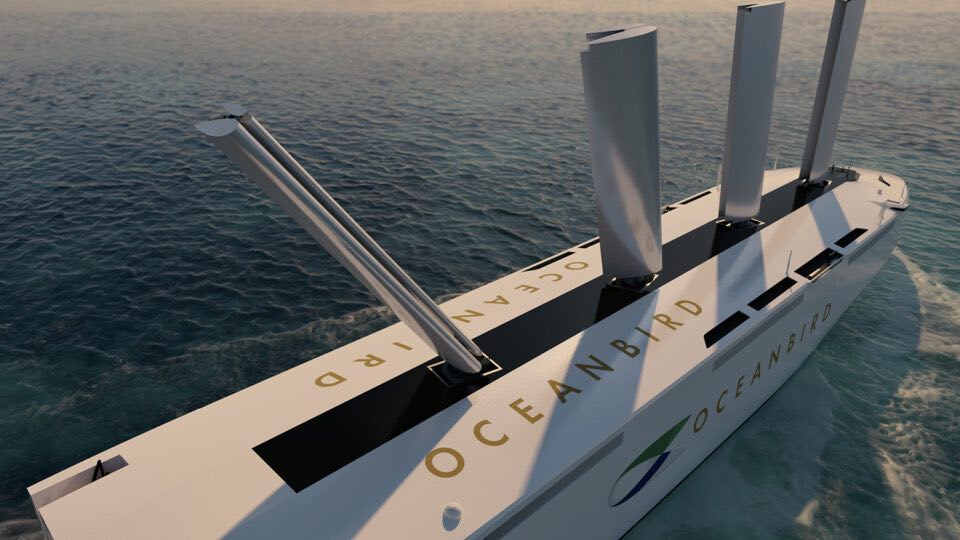28 November 2024
Wing sail model tested in KTH L2000 wind tunnel

Wing sail model tested in KTH wind tunnel by Oceanbird, a JV backed by Alfa Laval and Wallenius, and KTH Royal Institute of Technology.
Table of Contents
Concept
Oceanbird, a JV backed by Alfa Laval and Wallenius, and KTH Royal Institute of Technology are performing extensive tests on the Oceanbird wing model in the KTH L2000 wind tunnel.
The team is testing the aerodynamics of the wings while exposing them to different wind conditions. This series of tests is about finding the best way of trimming the wing in all possible configurations and the aerodynamics around stall hysteresis. It is the first wind tunnel test with the new two-segment wing design which optimizes the performance by creating a camber.
Configuration
The Oceanbird wing sail consists of a main sail and a flap. They form an asymmetric shape where the wind is accelerating on the outer part of the wing and decreasing on the inner part of the wing, increasing the lift and the overall performance. The design paves way for an adjustment of the overhaul shape by changing the angle of attack and creating a camber, which increases the performance dramatically, according to Oceanbird.
To allow the vessel to pass under bridges and reduce the power in hard weather, the wing can be folded and tilted.
Wing Sail Testing
“When the threads are moving around, it means that the flow is not attached. To get the largest lift force from the wind, we need to trim the wings in relation to the incoming flow so that they are as close as possible to the edge of where the flow is no longer attached and it stalls, but not crossing over it,”
Antonia Hillenbrand, Development Engineer at Oceanbird.
As explained, the tests have already contributed to the knowledge of how the flow on the wing looks, especially around the stall.
The tests also showed the sensitivity of aerodynamics to small changes in the environment, as well as changes in temperature and humidity.
“From my point of view, the most important will be tests for the control algorithm development. We need to understand the physics behind what’s happening on these wings a bit better, so we can control them in the best possible way,”
Ulysse Dhomé, PhD student at the Centre for Naval Architecture at KTH

Bow windshield, new rising containership feature
The bow windshield first invented by MOL could be set to go mainstream with news that two of the world’s largest liners have been installed on a flagship in its fleet.
Ship Nerd
After some adjustments to the 1-meter-high model of the wing sail, a new series of tests at the tunnel is scheduled to take place in March 2023. They will aim to validate the test setup and reduce uncertainties in the data. For this test round, the colorful threads have been removed.
“We got important knowledge from the threads, they are a very good visualisation for example of where the flow detached first on the wing. The air flow is super sensitive to tiny changes, so foreseeing the disturbance of the tufts, we removed them for the next tests. It is some crazy flow physics happening around the wing, the next tests will be very interesting,”
Antonia Hillenbrand, Development Engineer at Oceanbird.
Goals
The wing sail is being developed within the framework of a broader concept that envisages the construction of a wind-powered vessel, named Orcelle Wind. The vessel design builds on the Oceanbird concept, aiming to reduce up to 90% of emissions when compared to conventional vessels. The plan is to have it built and ready to sail in 2026.
The targeted reductions of 90% are set to be achieved by a combination of wing sails, specially designed hull, and speed/route recommendations.
The project is moving fast with the preparation for the installation of its first land-based Oceanbird Wing 560. This stage is critical before the project moves onto a vessel retrofitting stage.
See Also

SKYTUG: Primary Wind Propulsion for All Ships
Full power wind propulsion kite technology for existing ships. Opinion editorial by James McGarley, Managing Director, Bluewater Engineering.


